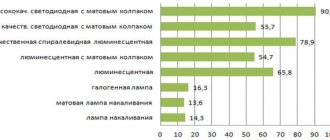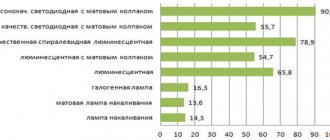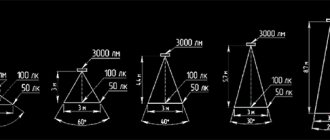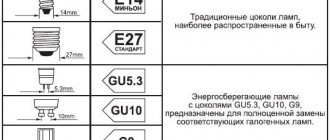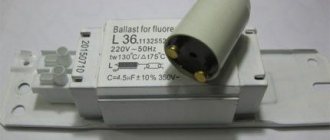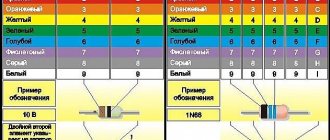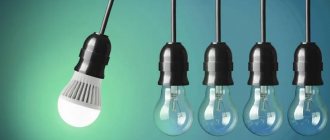What is a DRL lamp
Appearance of DRL lamps
First of all, it is worth understanding the name, because it is by this name that the master determines the characteristics and working conditions. The abbreviation DRL can be deciphered as follows:
- D – ignition type. The source ignites under the influence of an electric arc, which is formed when voltage is applied.
- R – mercury.
- L - the conversion of ultraviolet glow into visible light is carried out using a phosphor.
Also in the marking after the letters you can see a digital three-digit code. It shows the power for which the lamp is designed. On sale you can find devices with a power of 150 W, 200 W, 250 W, 400 W and other load values. In everyday life, light bulbs of 250 W and 400 W are usually used.
Electromagnetic type ballast
For an electromagnetic ballast, its connection diagram is as follows:
Electromagnetic ballast connection
Here the inclusion process involves the following actions:
- at the moment of current flow, energy accumulation occurs in the inductor;
- then it goes to the starter connectors;
- the current is directed to the starter through the electrode heating filaments;
- the electrons and the starter itself heat up;
- then the bimetallic contacts on the starter open;
- opening of connectors is accompanied by the release of electricity accumulated in the ballast;
- The voltage in the electrodes changes, which leads to a glow.
This way the lamps will be activated when using the above connection option.
Design features and principle of operation
The DRL lamp has a standard design for gas-discharge lamps. It consists of three parts - a glass flask, a base and a burner. Inside the burner there are electrodes and a limiting resistor. The air in the flask is evacuated, after which it is filled with nitrogen. A phosphor is applied to the inner surface. The burner contains a mixture of inert gases and mercury. Bulb sockets are different, the standard is E14 and E27.
DRL lamps work similarly to gas discharge lamps. When voltage is applied to live parts, a glow discharge occurs. As a result, electrons and ions accumulate and the inside of the tube heats up. The mercury evaporates, the glow discharge becomes an arc. As the amount of mercury vapor increases, the brightness of the glow increases. The resulting ultraviolet light hits the phosphor. When passing through it, it is converted into visible radiation.
Subject to operating conditions, the time it takes to turn on the light bulb and reach the stated parameters is about 4 minutes. As the temperature rises, this time decreases.
Operating principle of a fluorescent lamp
Fluorescent lamps take advantage of the ability of mercury vapor to emit infrared waves under the influence of electricity. This radiation is transferred into the range visible to our eyes by phosphor substances.
Therefore, an ordinary fluorescent lamp is a glass bulb, the walls of which are coated with a phosphor. There is also some mercury inside. There are two tungsten electrodes that provide electron emission and heating (evaporation) of mercury. The flask is filled with an inert gas, most often argon. The glow begins in the presence of mercury vapor heated to a certain temperature.
Basic design of a fluorescent fluorescent lamp
But normal network voltage is not enough to evaporate mercury. To begin work, start-up and control devices (abbreviated as ballasts) are turned on in parallel with the electrodes. Their task is to create a short-term voltage surge necessary to start the glow, and then limit the operating current, preventing its uncontrolled increase. These devices - ballasts - come in two types - electromagnetic and electronic. Accordingly, the schemes are different.
Types of DRL lamps
lamps DRL lamps have several modifications that have different technical characteristics and operating conditions.
- Classic DRL lamp. Standard modification. The disadvantages of the model include high heating during operation, sensitivity to voltage changes, and a long time to reach optimal performance characteristics. The most common are DRL 250 lamp and DRL 400. The luminous flux of DRL 250 allows the device to be used in home lighting.
- DRV or DRVED – tungsten mercury arc (erythemal tungsten) lamp. The product starts without using a choke and has improved light emission performance.
- DRLF - unlike a standard lamp, it has improved characteristics due to the coating of the bulb with reflective material.
All of the listed types can replace each other.
Mercury lamps DRL-70, DRL-125, DRL-250, DRL-400, DRL-700, DRL-1000
Mercury arc lamps of the DRL type are high-pressure gas-discharge mercury lamps, used for street lighting and lighting of large production areas.
DRL lamps are used in alternating current networks with a voltage of 220 V and a frequency of 50 Hz.
DRL lamps are turned on through ballasts (ballasts).
Marking:
D - arc; P - mercury; L - lamp.
Specifications:
Name
| Lamp voltage, V | Power, V | Length, mm (L) | Diameter, mm (D) | Base type | Luminous flux, lm | Service life, hours | |
| DRL 125 | 125 | 125 | 178 | 76 | E27 | 5900 | 12000 |
| DRL 250 | 130 | 250 | 228 | 91 | E40 | 13500 | 12000 |
| DRL 400 | 135 | 400 | 292 | 123 | E40 | 24000 | 15000 |
| DRL 700 | 700 | 357 | 154 | E40 | 41 000 | 20000 | |
| DRL 1000 | 1000 | 411 | 168 | E40 | 59000 | 18000 |
Connection diagram:
| 1. Main electrodes. 2. Ignition electrodes. 3. Electrode inputs. 4. Buffer gas (Argon - used for initial ionization and arc discharge). 5. PTC posistors (serve to limit the glow discharge current on the igniting electrodes). 6. Mercury (serves to change the potential gradient in the discharge). |
Thanks to the additional electrodes, the lamp does not require an igniter; it is connected to a network with inductive ballasts and ignites directly from a 220-volt network voltage.
The discharge occurs in an internal flask filled with argon.
The radiation spectrum consists of ultraviolet, and blue and green visible spectrum.
The components of the red region of the spectrum are completely absent.
A layer of phosphor on the inner surface of the outer bulb converts the ultraviolet component into light radiation from the red part of the spectrum.
The process of flaring up the DRL lamps after switching on lasts about seven minutes; the disappearance of voltage leads to the extinguishing of the lamp.
It is impossible to light a hot lamp; the lamp must cool completely. Advantages:
- high luminous efficiency (up to 60 lm/W)
- compactness, with high unit power
- ability to work at negative temperatures
- long service life (about 15 thousand hours)
Flaws:
- low color rendering
- light pulsation
- criticality to network voltage fluctuations
PRICES from 02.08.2017
| Name | Price | Qty. |
| Lamp HPL-N 125W base E27 Philips 871150018012430 | 281,75 | Thing |
| Lamp HPL-N 250W base E40 Philips 871150018060515 | 422,93 | Thing |
| Lamp HPL-N 400W base E40 Philips 871150018045210 | 629,72 | Thing |
| Lamp HPL-N 700W base E40 Philips 871150018391010 | — | Thing |
| Lamp HQL 125W E27 OSRAM 4050300012377 | 186,11 | Thing |
| Lamp HQL 250W E40 OSRAM 4050300015064 | 325,21 | Thing |
| Lamp HQL 400W E40 OSRAM 4050300015071 | 467,16 | Thing |
| Lamp HQL 700W E40 OSRAM 4050300015088 | — | Thing |
| Lamp HQL 80W E27 OSRAM 4050300012360 | 343,75 | Thing |
| DRL lamp-1000 W | 836,75 | Thing |
| DRL lamp-125 W | 108,17 | Thing |
| Lamp DRL 125 Phoenix (China) | — | Thing |
| DRL lamp 250 W | 133,23 | Thing |
| DRL 250 Phoenix lamp (China) | — | Thing |
| DRL lamp-400 W | 175,84 | Thing |
| Lamp DRL-400 Phoenix (China) | — | Thing |
| DRL lamp-700 W | 547,69 | Thing |
If you are interested in our products, call (mngk), 740-42-64, 973-65-17 or send a request by email
Specifications
In DRL lamps it is indicated in the marking. Also important indicators are:
- Light flow. This value determines how many light bulbs are needed to create the required level of illumination per unit area. DRL 400 has a luminous flux of 18,000 lm.
- Approximate operating time. Shows how many hours the light bulb can work under the stated conditions.
- Base. Sets parameters for a chandelier or other lamp.
- Dimensions.
- Supply voltage.
All these parameters, as well as operating conditions, can be found in the documentation for the lamp.
Design
The design includes the following elements:
- glass container;
- threaded base;
- mercury-quartz burner filled with argon. Additionally, a drop of mercury is added;
- main cathodes;
- additional electrodes;
- additional carbon resistor.
Helpful information! The purpose of the additional electrodes is to facilitate lighting of the lamp. They are also responsible for stable operation.
The elements are discussed in more detail below:
- base It receives electricity from the network as a result of contact of the current-carrying parts of the lamp with the contacts of the lamp socket. As a result, electricity is transferred to the burner electrodes;
- quartz burner. It looks like a flask with two electrodes on each side (two are main, two are additional). The burner is filled with argon and a drop of mercury;
- glass flask. This is the outer part of the light bulb. Inside there is a burner with connected electrical conductors coming from the contact base. To pump nitrogen into the flask, all the air is first pumped out of it.
You may be interested in The problem of light bulbs burning out, how to fix it
The first models of DRL lamps had only two electrodes. Such lamps were more difficult to light - an additional starting device was required. The modern, throttle version is equipped with four electrodes.
Device
Application area
DRL lighting devices are actively used as a source of artificial light in external and internal lighting: for illuminating roadways, highways, parks and squares, as well as production facilities and industrial workshops with a power of several megawatts.
DVR products are used in the same facilities as DRL, as well as in lighting agricultural enterprises that grow various crops in insulated soil. These can be greenhouses, greenhouses, gardens.
Switching option with two ballasts and two tubes
If you have two lighting sources, as well as two kits for connecting them, you need to use this option.
Connection with two sets
In this situation, the connection is carried out as follows:
- a phase wire is supplied to the inductor input;
- then it is sent from the throttle output to one contact of the housekeeper. In this case, from the second connector it goes to the first starter;
- from the first starter it is sent to the second pair of connectors of the same light source;
- the free connector must be connected to the neutral power wire, which is indicated in the figure as N
The second tube is switched on in the same way: first the throttle goes, then from it one connector is directed to the light bulb contact, and the second to the starter. The output from the starter must be connected to the second pair of lamp contacts, and the free connector must be connected to the neutral wire.
Connecting the lamp
The DRV modification does not require a choke for connection. The light bulb can be directly connected to the mains. The throttle lamp connection diagram requires a ballast. This device provides regulation of the current within specified limits. Using a choke, you can prevent the light source from burning out and create a mode for starting it. The inductor also corrects the operation of the device by stabilizing the operating voltage supplied to the contacts.
There are two types of chokes - independent and built-in. They are installed in various luminaire designs and depend on the installation location of the ballast (ballast).
The choice of ballast model is influenced by the following parameters:
- electric power of a light bulb;
- operating current and voltage;
- winding temperature;
- maximum permissible heating;
- greatest power loss;
- Power factor.
The most common breakdown in gas-discharge DRL lamps is associated with problems with the ballasts. The device will not light up during operation. For this reason, it is important to be able to check the throttle for functionality. This can be done using a multimeter, which will check the integrity of the windings and the presence of an interturn short circuit.
Another way to check is with an incandescent lamp of the same power connected in series to the circuit. If the product is in good working order, the light will turn on at half power or flash. If there is no light, you can judge that the winding is damaged. Too bright a light indicates the presence of an interturn short circuit.
Throttle overheating and possible consequences
Using light bulbs that have reached the end of their service life and occasionally experience various breakdowns can result in a fire. How to dispose of used fluorescent devices is written in detail here.
Regular inspection of the condition of lighting fixtures - visual inspection, checking of main components - will help to avoid the occurrence of a fire hazard.
Towards the end of the lamp's service life, you may notice significant overheating of the ballasts - of course, you cannot check the temperature with water; for this you should use measuring instruments. Heating can reach 135 degrees or higher, which is fraught with dire consequences
If used incorrectly, the bulb of a mercury lamp may explode. The smallest particles can scatter within a radius of three meters. Moreover, they retain their incendiary abilities even if they fall from the ceiling to the floor.
The danger is posed by overheating of the inductor winding - the device consists of various types of materials, each of which has its own characteristics. For example, manufacturers impregnate insulating gaskets with complex compounds, individual elements of which have different flammability and ability to generate smoke.
Even seven turns of the throttle in which a short circuit occurs can become a fire hazard. Although a high probability of fire is a short circuit of at least 78 turns - this fact was established experimentally
In addition to overheating of the throttling element, there are other situations with fluorescent lighting that pose a fire hazard.
It can be:
- problems caused by violations of ballast manufacturing technology, which affected the final quality of the device;
- poor material of the lighting fixture diffuser;
- ignition circuit - with or without a starter, the fire hazard is the same.
It should be remembered that problems can be caused by negligence when making connections, poor quality of contacts or circuit components, which most often occurs when using very cheap devices purchased from unknown manufacturers.
Conscientious companies provide a guarantee for their products, and the technical parameters of the devices indicated on the case or packaging correspond to reality. This fact directly affects the service life of both the ballast itself and gas-discharge light bulbs, the features of the device and operation of which will be introduced in our recommended article.
Advantages and disadvantages
DRL lamps are quite popular light sources. This is due to their positive qualities, which include:
- long service life;
- compactness;
- standard plinths;
- good luminous flux;
- reduced energy consumption.
Disadvantages limiting the use of light bulbs:
- Susceptibility to voltage changes.
- The presence of pulsations that are harmful to human health.
- Long ignition time.
- The presence of harmful ultraviolet light.
- Lamp modifications have lower efficiency and service life.
- The presence of harmful components in the composition.
- Fragility. The glass flask is easy to break, so you need to work with the device carefully.
- Difficulty in recycling. Mercury and other harmful substances contained in the device mean that the light bulb should not be thrown away with household waste. It is disposed of at special collection points.
Despite all the advantages of such light sources, most electricity consumers switch to LED analogues. They are safer, have a longer service life and improved performance. The LED lamp E40, an analogue of the DRL 400, has already practically replaced the gas-discharge product.
In 2014, the Russian Federation signed the Minamata Convention. According to this document, starting from 2022, the production, use, export and import of mercury products must be stopped. Gas-discharge devices are prohibited, so it is now recommended to think about replacing DRL 400 with LED lamps with improved characteristics and a high degree of environmental friendliness. This applies to both home and industrial and street lamps.
Alternative lighting sources
An energy-saving LED lamp is an excellent analogue to other lighting sources, including DRL; if you buy it, you can significantly save on electricity. Replacing street lighting will pay for itself after three years of operation, even taking into account the refurbishment work.
Many well-known foreign and Russian companies (for example, Lisma) are engaged in the production of these lighting devices. Currently, the price of these devices is slightly higher than the cost of a DRL lamp, but in the near future this problem will be eliminated, which will make LED lighting sources more accessible in Moscow, St. Petersburg, as well as in cities such as Saransk or Yekaterinburg.
DRL and DVR lamps are a common type of gas-discharge mercury lamps. They are used for street and indoor lighting. Both types are almost identical in appearance, especially when turned off. These are very efficient light sources in terms of energy saving, with a luminescence rate of 30 lm/W. This is quite a lot, but more modern varieties of light bulbs can have an output of 50 lm/W. Such lighting equipment is produced by many world-famous brands. It should be noted that due to the mercury content in lamps, they are prohibited in many countries, so the number of DRLs and DVRs is gradually decreasing.
How do DRL and DRV lamps work?
A quick glance at these lighting devices reveals some similarities with ordinary incandescent lamps with an E27 base. However, HID lamps have white tinted glass, with a transparent area just in front of the base. It is precisely because of the opacity that it is impossible to see that such devices have a specific structure inside.
Design and principle of combustion of DRL lamps
DRL (Arc Mercury Phosphor) lamp. Its design provides:
1 - Threaded base 2 - Resistor 3 - Molybdenum foil 4 - Ignitor (auxiliary) 5 - Supporting frame 6 - Outer bulb 7 - Compressed junction 8 - Mercury quartz arc discharge lamp 9 - Nitrogen filler 10 - Tungsten electrode (main) 11 - Lead wire
The base has a standard design, like the vast majority of household light bulbs used in chandeliers and lanterns. It receives electricity transmitted to its surface. It has two reception points. One electrode is located in the center, and the side of the base serves as the second electrode. The base is threaded into the lamp socket.
The main working element of the lamp is a quartz burner. On its sides there is a pair of electrodes. One is main and the other is auxiliary. They are located in an internal quartz flask filled with argon and mercury vapor.
The glass flask is placed on top of the quartz flask. To fill the space, nitrogen gas is pumped into it. The inside of the flask is painted with a white phosphor, so it is not transparent.
The operating principle of such lamps is more complex than that of incandescent lamps. When electricity is supplied to nearby electrodes, a glow discharge is created. This causes a breakdown of energy between them. As a result, the glow discharge develops into an arc discharge. It creates blue or violet radiation in the lamp. It provokes a bright glow of the phosphor, which colors the inside of the glass bulb. The phosphor itself produces a reddish light. As a result of mixing shades of red, blue, violet, a bright, almost white color is created.
Current fluctuations greatly affect the efficiency of the DRL glow. Even with electrical voltage surges of up to 15%, brightness drops can be as much as 30%. If the voltage drops to 80%, the lamp will go out.
The big disadvantage of such light bulbs is their strong heating. As a result, the insulation on the wire may burn out. Therefore, when connecting, you need to use only specialized heat-resistant cartridges and cable. In the light bulb itself, the pressure increases greatly during operation. In this regard, after turning it off, you need to wait until the flask has completely cooled down. If you turn on a hot light bulb again, it simply won’t light up.
The use of a DRL lamp implies the mandatory use of ballasts. A throttle is usually used as it. It limits the current that is supplied to power the lamp. The throttle matches the light fixture's power and directs the optimal amount of energy to it to minimize overheating and prevent uncomfortable lighting. If you do not use a ballast when turning on the lamp, the lamp will fail almost instantly.
Parameters and characteristics of the inductor
When choosing a ballast, you need to take into account its characteristics.
One of the main parameters is inductance, which is measured in H (Henry). The amount of reactance of the switched on ballast depends on its inductance. This value characterizes the magnetic properties of an electrical circuit. 1Gn passes 1A of current at a voltage of 1V. The main parameters of the inductive coil include:
- coil length in m;
- number of turns;
- permeability of the core material;
- cross-sectional size of the magnetic circuit;
- magnetic saturation.
The inductance of the ballast winding depends on all the characteristics described above.
The resistance of the coil winding turns depends on the cross-sectional area of the core. Therefore, when choosing ballasts for HPS, you need to take into account their power, on which the rated load current depends. Accordingly, the dimensions of the electric ballast depend on the power of the lamp.
Device
The shape of the product is oblong, reminiscent of ordinary incandescent light bulbs. But there are certain design differences between them.
The DRL includes the following elements:
- a glass bulb is something that almost all light sources have. Used to protect internal parts;
- metal base - used for screwing into the lampshade of an electrical appliance;
- a tube filled with mercury vapor. It is placed inside a glass flask and is made of quartz glass. Usually mercury is diluted with argon;
- lamps can be equipped with secondary electrodes and cathodes. This speeds up the ignition of the product, reaching the operating mode and increases stability;
- A carbon resistor is needed to connect the electrodes and cathodes.
Comparison of DRL light bulbs with analogues
Discharge lamps are often compared with each other and with more profitable LEDs. The closest analogues of DRL are three types of illuminators: DRI, DRI and DNAT. Let's try to identify the features and competitive advantages of different light bulbs.
DRV. A mercury-tungsten arc lamp is very similar in design and operating principle to a DRL. Structurally, inside the flask there is a mercury discharge torch and a tungsten spiral. The last element limits the current for the burner, which means that additional ballasts are not needed.
The main differences between mercury-tungsten lamps and DRLs:
- They consume more electricity - the luminous flux of DRV 250 is no more than 5500 Lm;
- estimated operating time – 3000 hours;
- lights up within 1 minute.
DRI. Mercury arc lamps with emitting additives: indium, sodium, thalium halide, etc. Metal components increase the light output of devices to 75-90 Lm/W.
An additional advantage of metal halide mercury lamps is improved color rendering. To operate DRI, like DRL, they require connection via a choke
DNAT. Sodium arc lamps boast the highest light output and longest operating life among discharge illuminators. The performance of sodium light bulbs does not decrease as noticeably over time as DRL lamps.
Characteristics of DNAT:
- maximum light output – 125 Lm/W;
- operability – within 20 thousand hours;
- relative stability of parameters;
- wide range of operating temperatures;
- reaching maximum illumination in 5-7 minutes.
Disadvantages of sodium light sources: significant pulsation and low color rendering coefficient, Ra=25. The emission spectrum is dominated by red and yellow colors.
Discharge lamps are confidently giving way to LED options. LED devices are superior to their predecessors in all technical and operational parameters.
The undeniable advantages of LEDs: environmental friendliness, minimal pulsation, service life, instant switching, excellent color reproduction and contrast. In addition to excellent performance characteristics, diode devices have temperature and mechanical resistance.
The efficiency of LED lamps is unrivaled, operating efficiency reaches 95-98%. The main factor somewhat constraining the re-equipment of lamps is the high price of LED lamps

